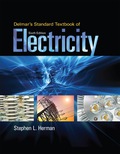
Concept explainers

The missing values in the given table.
Answer to Problem 8PP
| EP = 277 V | ES1 = 480 V | ES2 = 208 V | ES3 = 120 V |
| IP = 8.93 A | IS1 = 2.4 A | IS2 = 3.47 A | IS3 = 5 A |
| NP = 350 turns | NS1 = 606 turns | NS = 263 turns | NS = 152 turns |
| Ratio 1 =1:1.73 | Ratio 2 =1.33:1 | Ratio 3 = 2.30:1 | |
| R1 =200 Ω | R2 = 60 Ω | R3 = 24 Ω |
Explanation of Solution
The transformer in the fig 27-17 contains one primary winding and three secondary windings.
The primary is connected to 277 V AC and contains 350 turns of wire.
One secondary has an output voltage of 480 volts and a load resistance of 200 Ω.
Second secondary has an output voltage of 208 volts and a load resistance of 60 Ω.
Third secondary has an output voltage of 120 volts and a load impedance of 24 Ω.
The turns ratio of the first secondary can be found by dividing the smaller voltage into the larger:
The turns ratio of the first secondary is re written as,
The current flow in the first secondary can be calculated using Ohm’s law:
The amount of primary current needed to supply this secondary winding can be found using the turns ratio. As this primary has less voltage, it requires more current:
The number of turns of wire in the first secondary winding is found using the turns ratio. Because this secondary has a higher voltage than the primary, it must have more turns of wire:
The turns ratio of the second secondary winding is found by dividing the higher voltage by the lower:
The turns ratio of the second secondary is re written as,
The amount of current flow in this secondary can be determined using Ohm’s law:
The amount of primary current needed to supply this secondary winding can be found using the turns ratio. As this primary has more voltage, it requires less current:
Because the voltage of this secondary is lesser than the primary, it has less turns of wire than the primary. The number of turns of this secondary is found using the turns ratio:
The turns ratio of the third secondary winding is calculated in the same way as the other two. The larger voltage is divided by the smaller:
The turns ratio of the third secondary is re written as,
The secondary current is found using Ohm’s law:
The amount of primary current needed to supply this secondary winding can be found using the turns ratio. As this primary has more voltage, it requires less current:
Because the voltage of this secondary is lesser than the primary, it has less turns of wire than the primary. The number of turns of this third secondary is found using the turns ratio:
The primary must supply current to each of the three secondary windings. Therefore, the total amount of primary current is the sum of the currents required to supply each secondary:
Want to see more full solutions like this?
Chapter 28 Solutions
EBK DELMAR'S STANDARD TEXTBOOK OF ELECT
- Answer letter (c) onlyyyarrow_forwardSolve for the currents I1, I2 and I3. Use KVL and KCL to derive the equations and use Gauss-Jordan Elimination to solve for the unknowns. (Answer should be in this format: I1=____, I2=_____, I3=_____). Answers should be at least 2 decimal places.arrow_forwardsolve for nodal voltages and unknown variablesarrow_forward
- I would like to understand how to solve using Cramers Rule method.arrow_forwardpls do not use nodal or source transform. kindly use current divisionarrow_forwardThe reactance of a generator is given as 0.25 per-unit based on the generator’s of 18 kV, 500 MVA. Find its per-unit reactance on a base of 20 kV, 100 MVA. a. 0.0505 b. 0.0605 c. 0.0405 d. 0.0606arrow_forward
 Introductory Circuit Analysis (13th Edition)Electrical EngineeringISBN:9780133923605Author:Robert L. BoylestadPublisher:PEARSON
Introductory Circuit Analysis (13th Edition)Electrical EngineeringISBN:9780133923605Author:Robert L. BoylestadPublisher:PEARSON Delmar's Standard Textbook Of ElectricityElectrical EngineeringISBN:9781337900348Author:Stephen L. HermanPublisher:Cengage Learning
Delmar's Standard Textbook Of ElectricityElectrical EngineeringISBN:9781337900348Author:Stephen L. HermanPublisher:Cengage Learning Programmable Logic ControllersElectrical EngineeringISBN:9780073373843Author:Frank D. PetruzellaPublisher:McGraw-Hill Education
Programmable Logic ControllersElectrical EngineeringISBN:9780073373843Author:Frank D. PetruzellaPublisher:McGraw-Hill Education Fundamentals of Electric CircuitsElectrical EngineeringISBN:9780078028229Author:Charles K Alexander, Matthew SadikuPublisher:McGraw-Hill Education
Fundamentals of Electric CircuitsElectrical EngineeringISBN:9780078028229Author:Charles K Alexander, Matthew SadikuPublisher:McGraw-Hill Education Electric Circuits. (11th Edition)Electrical EngineeringISBN:9780134746968Author:James W. Nilsson, Susan RiedelPublisher:PEARSON
Electric Circuits. (11th Edition)Electrical EngineeringISBN:9780134746968Author:James W. Nilsson, Susan RiedelPublisher:PEARSON Engineering ElectromagneticsElectrical EngineeringISBN:9780078028151Author:Hayt, William H. (william Hart), Jr, BUCK, John A.Publisher:Mcgraw-hill Education,
Engineering ElectromagneticsElectrical EngineeringISBN:9780078028151Author:Hayt, William H. (william Hart), Jr, BUCK, John A.Publisher:Mcgraw-hill Education,





